Before you start learning to solve, there are a few things you should have, and a few
things you should know:
- First of all, you’ll need a 2×2 Rubik’s cube, which you obviously have or you
wouldn’t be reading this. - It’s strongly advised (but not necessary) to have complete, or at least partial, knowledge of how to solve a 3×3 cube. This is because solving a 2×2 cube is very closely related to solving a 3×3. The 2×2 is like a 3×3 cube without edge or center pieces (displayed in picture below)
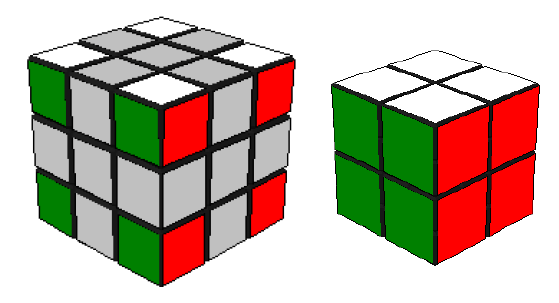
- It’s recommended that you read (or at least look over) the “Ryan’s Guild to Speed Cubing” before reading this due to the fact that the method and algorithms are insanely close to being the same.
- When a 2×2 cube is solved, the colour scheme will always remain the same no matter how many times you solve. For example if your cube’s colour scheme is White opposite Yellow, Green opposite Blue, and Red opposite Orange, green and blue will never be adjacent when solved because they are on opposite sides.
- If you have no experience with solving Rubik’s cubes what so ever, there is an element or memorization required but don’t let this worry you, with practice you’ll remember everything with ease.
- It’s also recommended (if you want to solve fast) that you lubricate your cube by spraying silicone (such as Jig-A-Loo) lube into the cracks of the cube and working the lube around.
This tutorial uses the same method used in the “Ryan’s Guild to Speed Cubing” except without any steps involving edges. So first, you solve the first layer, then you orient the last layer, then you permute the last layer. This may sound very confusing to you (or not make sense at all) but don’t worry, everything will be explained in the
following pages. Before we start getting into solving the first layer, there are some important things you should learn like how to read cube notation and learning the names of the faces on the cube. If you can already solve a 3×3 Rubik’s cube or are familiar with notation and face names, then you can skip this part.
Face Names:
Face names are very simple to understand and they let you know which face to turn while reading cube notation.
Now if you hold your cube strait in front of your face, the face of the cube directly in front of you is called the F face, which stands for Front. Pretty easy right?
The cube faces on the right and left side of the cube are the R and L faces. R standing for Right and L standing for Left.
The face on top is U for Up face. The bottom is D for Down face.
And the back face is B for Back. Just remember that the bottom face isn’t B or else you’ll have 2 B faces.
In the diagrams I use for examples, I will use the following face positions: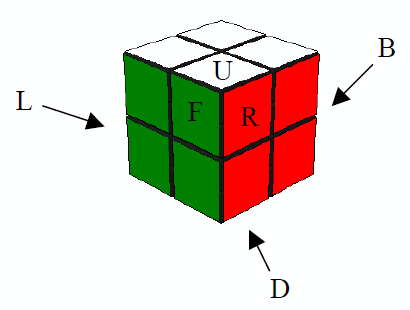
Cube Notation:
Cube Notation is basically the language of algorithms. An Algorithm (algo for short) is a sequence of moves that
causes certain pieces on the cube to move or rotate in certain ways. These algos are written down using cube notation. Cube Notation lets the reader know what face to turn, in which direction so they can use the algo.
Here is an example algorithm (If you don’t know this one yet, don’t learn it and get head of yourself) R U R’ U R U2 R’. This algorithm contains 3 of the 6 cube notation tags. The 6 notation tags are: just a capital letter, a capital letter with an apostrophe, a capital letter with a 2, a lower case letter, a lower case letter with an apostrophe, and a lower case letter with a 2. If you have just a capital letter, you would turn the face with the same name as that letter clockwise 90°. If you have a capital letter with an apostrophe, you would turn the specified face counterclockwise 90°. If the capital letter has a 2 beside it, then you turn that face 180°.
Here are some examples: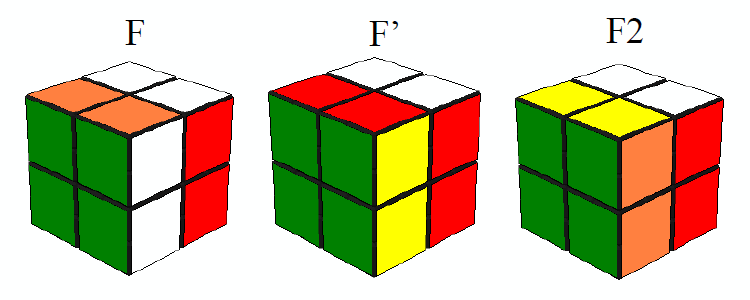
There are more aspects of cube notation such as lower case notation and M, E, and S turns but these don’t apply to the 2×2 so I’ll leave those aspects for solving a 3×3.
However, there is one more thing about cube notation to teach, these are x, y, and z rotations. Alike U, R, L, F, D, and B turns, x y z rotations can also be found as just capital, capital with an apostrophe, and capital with a 2.
For these the same rules apply: capital = 90° clockwise, apostrophe = 90° counterclockwise, 2 = 180°. The only difference is, when performing an x, y, or z rotation, you don’t turn a face, you rotate the whole cube. The cube has three axes, the x-axis runs through the right and left sides of the cube, the y-axis runs through the top and bottom of the cube, and the z-axis runs through the front and back of the cube.
So for example, an x rotation would rotate the cube 90° clockwise along the x-axis, a y’ rotation would rotate the cube 90° counterclockwise along the y-axis, and a z2 rotation would rotate the cube 180° along the z-axis.
Here are examples of rotations:
Step1: Solving the first layer
Now that you know everything you need to know in order to start solving a 2×2 Rubik’s cube, lets start with solving the first layer. To the right is a picture of a completed first layer (the grey represents that it doesn’t matter what colour that piece is), now lets learn how to get there. If you can already solve a 3×3, you can skip this step because it’s just like inserting first layer corners.
To start, find a corner piece with white on it as your starting point (it’s best to start with white because when solving the cube fast, white is the easiest colour to spot so you can find your pieces faster). Now put the white sticker of that piece on the U face. Now find another white piece with one of the colours on that piece (other than white) match up
with one of the colours on your starting piece. For example, if your starting piece is the White Green Red piece and the other piece you found is the White Green orange piece, then you found the right second piece because they both share the colour green. However if your starting piece is White Green Red and your second piece is White Blue Orange, although they both share the colour White, they are matching piece because they have to have a matching colour other than white.
First, rotate the faces around so that your second piece is under your starting piece. In my example I’ll use White Green Red as my starting piece and White Green Orange as my second piece. It will then look like this (the all white piece represents the White Green Orange piece. I used white because it doesn’t matter which way the oriented
(rotated) right now.
Next, move the second piece to either the left or right side of the starting piece depending on the colour that matches. Since my starting piece has White Green and Red and my second piece has White Green and Orange, Green is the matching colour. Now since green is on the left side of my starting piece, I want to move my second piece to the
left. This is demonstrated in the example below:
Since they share the colour green, I moved my second piece to the green side. 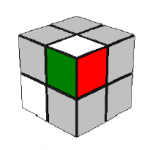
Now rotate the whole cube so that the second piece is in front of you instead of the starting piece. Now you will have one of these three cases (in my examples I will continue to use White Green Red as the starting piece and White Green Orange as the second piece) :

Case 1 is a simple three-move algorithm. R’ D’ R:

Case 2 is almost the same as case 1 except it’s mirrored. F D F’:

Case 3 is my least favourite because it takes two steps. Do these moves R’ D2 R D:

Voila! you now have case 1!
Now you should have a 1x1x2 block like this: 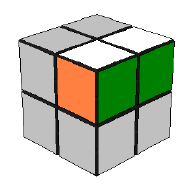
Once you have the 1x1x2 block, find another white corner piece and repeat the same process you did for the second one. Then repeat again for the forth and you’ll end up with a successful first layer. This will all be possible unless you come across something like this:
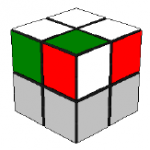
This is common problem but luckily, it’s very easy to fix. To fix this, just perform either case 1 or case 2 to insert a different piece into the slot with the incorrect piece in it. This will take out the incorrect piece so that you can insert it properly.
Congratulations! you have officially solved the first layer of a Rubik’s 2×2 cube. Now there are only two more steps until you’re done. But before you move onto those steps, you should keep scrambling your cube and solving the first layer over and over again. This is necessary so that you will never forget how to solve the first layer. Also, the more time you spend practicing, the faster you’ll be able to solve the cube.
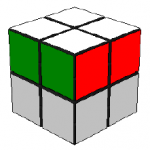
Step 2: Orienting the last layer
Now that the first layer is solved, it’s time to flip over your cube. You’ll now have 1 of 7 possible cases for this step. If you have read the Ryan’s Guide to Speed Cubing or use a similar 3×3 solving method, then you will know what to do here. For those of you who don’t know what to do, you’re looking in the right place. If you’re still unsure about the meaning of orientation, orientation is just flipping the pieces. To orient the last layer, you’ll want to flip the pieces so that they are yellow side up like in the picture to the right. As I mentioned before, there are 7 cases for this step but
luckily for you, you’ll only have to learn 2 algs. To demonstrate top layer algorithms, I will use a diagram like this with the following face names:
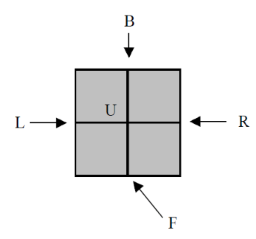 You’ll often see a yellow line on the side of a square, this just lets you know where a yellow is that you can’t see
You’ll often see a yellow line on the side of a square, this just lets you know where a yellow is that you can’t see
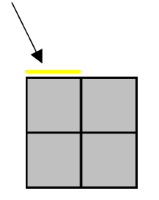
The two algos you’ll have to learn to orient the last layer are the left and right Soon algos. Luckily for you, these algorithms aren’t very hard to remember but you will have to remember where to use which Soon on which case. First I will show you the two cases that require only one Soon algorithm.
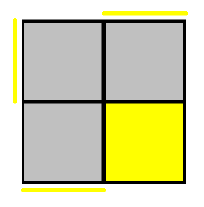
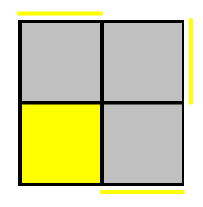
These next 5 cases require 2 or more Soon algorithms.
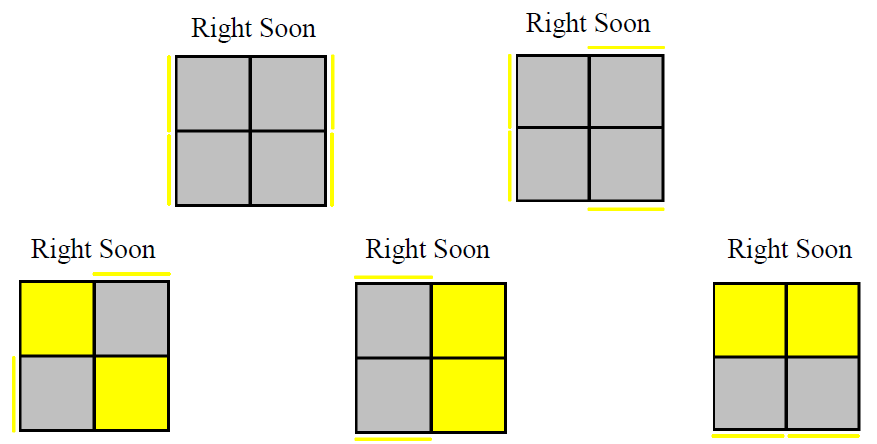
Now with what I have taught you, your cube should look something like this one. Now, don’t forget to practice, practice, practice up to this step or else you might forget. You’re almost finished solving your 2×2 now, there’s only one step left. Luckily for you, this next step only requires memorizing one more algorithm except this alg is a bit
trickier than the previous ones.
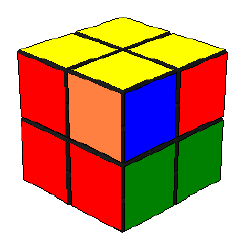
Step 3: Permuting Last Layer
As well as orienting, permuting is probably a new word to you. Permuting means to cycle certain pieces while remaining the same orientation. If you can already solve the 3×3 with the same method in the Ryan’s Guide to Speed Cubing, then you just have to do the same you would for permuting Last Layer corners.
To start, find a pair of last layer corners with adjacent colours matching (if you don’t have any, don’t worry, keep reading). Then pair them up with the first layer pieces of the same colour so you end up with a 1x2x2 block. Here’s an example:
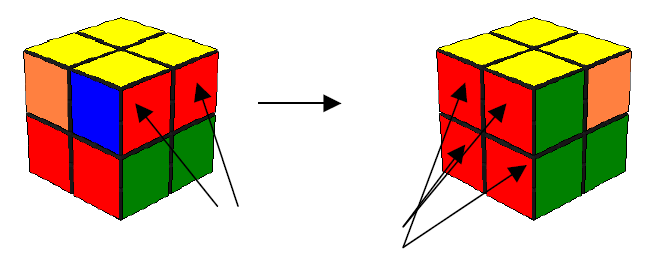 Once your cube is aligned like in my example, perform the next alg with the big square of 4 as the back face (in my example, it’s red). If you don’t have any matching pairs, just perform this next alg with any face (except white or yellow) as the back face.
Once your cube is aligned like in my example, perform the next alg with the big square of 4 as the back face (in my example, it’s red). If you don’t have any matching pairs, just perform this next alg with any face (except white or yellow) as the back face.
Corner permutation algorithm: x R’ U R’ D2 R U’ R’ D2 R2 x’
CONGRATULATIONS! You have now officially solved the Rubik’s 2×2 cube. Like I said, don’t forget to practice because if you don’t practice, you won’t be able to solve the cube without instructions. Now with your newfound
skills, you can go and show your friends and when your friends say “Oh that’s easy, it’s only a 2×2.” let them give it a shot and see how hard it really is. With practice, you will definitely get faster, then you can enter a tournament and show off your new skills.


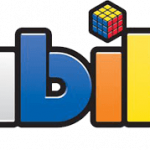
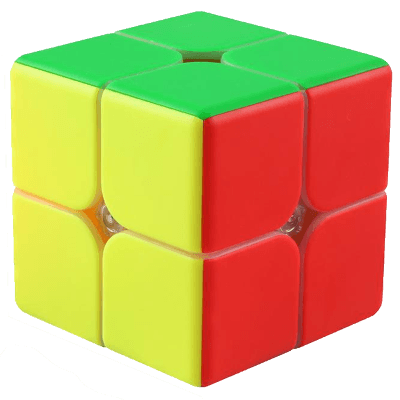

Please put a pdf guide for 2*2 cube formula